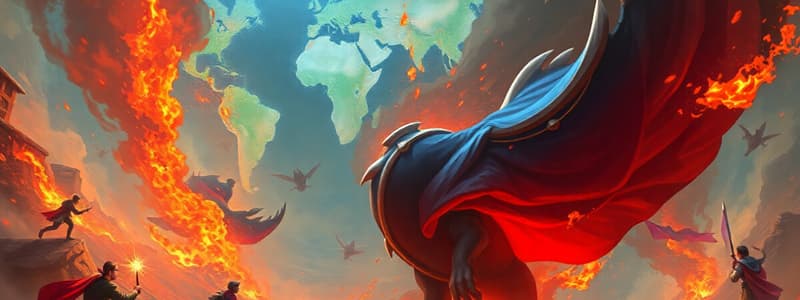Podcast
Questions and Answers
What was the main objective of the Kellogg-Briand Pact established in 1928?
What was the main objective of the Kellogg-Briand Pact established in 1928?
To agree not to use force to settle disputes.
What event initiated the Great Depression in October 1929?
What event initiated the Great Depression in October 1929?
The Wall Street Crash.
What triggered the Japanese invasion of Manchuria in 1931?
What triggered the Japanese invasion of Manchuria in 1931?
The Mukden Incident, where a section of railway was blown up.
What significant information did Lord Lytton investigate after the Mukden Incident?
What significant information did Lord Lytton investigate after the Mukden Incident?
What significant political change occurred in Germany in February 1933?
What significant political change occurred in Germany in February 1933?
What was the purpose of the Stresa Front formed in 1935?
What was the purpose of the Stresa Front formed in 1935?
What critical event took place in March 1936 regarding the Rhineland?
What critical event took place in March 1936 regarding the Rhineland?
What happened in May 1936 that marked a significant victory for Italy?
What happened in May 1936 that marked a significant victory for Italy?
What was the significance of Haile Selassie's address to the League in June 1936?
What was the significance of Haile Selassie's address to the League in June 1936?
In 1937, Japan's invasion of which country is considered a starting point of WWII?
In 1937, Japan's invasion of which country is considered a starting point of WWII?
What was the fate of the League of Nations during the period from 1937 to 1946?
What was the fate of the League of Nations during the period from 1937 to 1946?
What agreement did Japan and Germany pursue in 1933 regarding the League of Nations?
What agreement did Japan and Germany pursue in 1933 regarding the League of Nations?
What conflict arose between Italian and Abyssinian troops in December 1934?
What conflict arose between Italian and Abyssinian troops in December 1934?
What was the outcome of the disarmament conference that started in October 1932?
What was the outcome of the disarmament conference that started in October 1932?
Flashcards
Kellogg-Briand Pact
Kellogg-Briand Pact
A pact signed by 65 nations in 1928 aimed at preventing war through peaceful settlement of disputes.
Wall Street Crash
Wall Street Crash
This event in 1929 marked the beginning of the Great Depression, a period of widespread economic downturn.
Mukden Incident
Mukden Incident
An incident where the Japanese army blamed a section of the Manchurian railway being blown up on China, leading to their invasion of Manchuria in 1931.
Lord Lytton's Investigation
Lord Lytton's Investigation
Signup and view all the flashcards
Far East Conflict (February 1932)
Far East Conflict (February 1932)
Signup and view all the flashcards
Disarmament Conference (1932)
Disarmament Conference (1932)
Signup and view all the flashcards
Hitler Appointed Chancellor
Hitler Appointed Chancellor
Signup and view all the flashcards
Japan Leaves the League of Nations
Japan Leaves the League of Nations
Signup and view all the flashcards
Wal Wal Incident
Wal Wal Incident
Signup and view all the flashcards
Stresa Front
Stresa Front
Signup and view all the flashcards
Hoare-Laval Plan
Hoare-Laval Plan
Signup and view all the flashcards
Remilitarization of the Rhineland
Remilitarization of the Rhineland
Signup and view all the flashcards
Addis Ababa Falls to Italy (1936)
Addis Ababa Falls to Italy (1936)
Signup and view all the flashcards
Haile Selassie's Address (1936)
Haile Selassie's Address (1936)
Signup and view all the flashcards
Japanese Invasion of China (1937)
Japanese Invasion of China (1937)
Signup and view all the flashcards
Study Notes
International Relations 1928-1937
- 1928: The Kellogg-Briand Pact was signed by 65 nations, agreeing not to use force in disputes.
- Oct 1929: The Wall Street Crash triggered the Great Depression. Unemployment skyrocketed, impacting global trade severely.
- 1931: Japan invaded Manchuria (Mukden Incident) in retaliation for an incident on the railway.
- 1932: The Lytton Report, commissioned by the League of Nations, identified Japan's aggression.
- 1933: Germany withdrew from the League of Nations and began rearmament under Hitler.
- 1935: Italy invaded Abyssinia (Ethiopia) despite League sanctions, highlighting the League's failure to enforce peace. The Hoare-Laval Plan proposed a division of Abyssinia but was leaked and caused controversy.
- 1936: Germany remilitarized the Rhineland, demonstrating the League's weakness.
- 1937: Japan's expansion into China marked a major escalation of conflicts and is considered the true start of World War II by some historians.
- 1937-1946: The League of Nations ceased functioning, with the UN taking its place in 1946.
Key Events and Organisations
- League of Nations: An international organization established after World War I to prevent future wars, evidenced as ineffective in preventing the coming conflicts.
- Aggression: Countries utilizing force to achieve political or territorial goals.
- Great Depression: Global economic downturn impacting nations' ability to maintain peace.
- Disarmament: Reduction or elimination of weapons.
- Sanctions: Measures taken (like international trade cuts) aimed at punishing a nation for their actions.
Studying That Suits You
Use AI to generate personalized quizzes and flashcards to suit your learning preferences.
Description
Explore key events shaping international relations from 1928 to 1937. This period includes significant agreements like the Kellogg-Briand Pact and pivotal conflicts such as Japan's invasion of Manchuria and Italy's attack on Abyssinia. Understand how these events highlighted the weaknesses of the League of Nations and set the stage for World War II.




